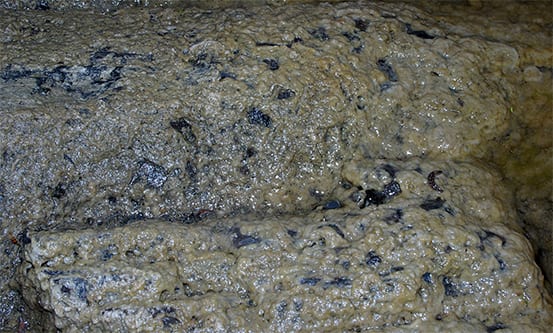Brown, tan or yellow mat of algae at the bottom of water body
- English Name: Didymo, Rock Snot
- Latin Name: Didymosphenia Geminata
- Propagate: Vegetative fragmentation
- Symptoms: Brown, tan or yellow mat of algae at the bottom of water body
- Dangers: Covers fish eggs, degrades water quality, affects fish food and fishing
Survival Tactics of Rock Snot Water Weed
Didymo is not native to America. It is a northern Europe import that has since settled successfully across most of the US. Young colonies of the weed are harmless and almost pleasant looking “pimples” on submerged rocks or water beds, but when they get going, they form impenetrable mats of unsightly “snot” that can get eight inches think. Few other plants can survive the onslaught.
The trick to this weed’s survival success is that it is a perennial plant that grows through the seasons and multiplies vegetatively from fragments of mature plants. Rock Snot also has the advantage of being able to live in water with little nutrients, plus sticking to the bottom of water bodies where it is harder to be reached by animals or birds.
But the weed’s real secret weapon is that combination silica body content and dead mucus. Few animals or birds find that mix appetizing. Also, the combination makes it easy for just about anything that comes into contact with the weed to serve as a carrier to new territory. It is also what gives the weed the ability to stay alive for month in a dry environment such as the side of a boat, fishing equipment or shoes soles.
The only major weakness that Rock Snot has is that it requires shallow water so as to get enough sunlight.
How to keep Didymo Rock Snot weeds in Check
Didymo weeds are a nuisance wherever they take hold. They basically smother the entire river bed, making it near impossible for other weeds to grow and even covering fish eggs. Fishing is difficult where the weed is well established and, of course, swimming in “snot” is not an inviting prospect. Fortunately, the snot does not pollute water in the sense of making it undrinkable although people swimming downstream of a big Rock Snot colony may suffer some eye irritation.
The standard way of getting rid of the Didymo snot is to dredge it out. The method rarely eradicates the weed totally because whatever tiny parts of it that remain behind starts a new colony. This weed is a single cell invasive algae (diatom) : We are unsure if LBB works on this Algae –since not much data is available. It will cover it but its in shallow streams and who knows if it will work.
Can didymo be eradicated once it becomes established?
There are currently no known methods for controlling or eradicating didymo once it infests a water body.
How is didymo spread?
The primary way for didymo to be spread is by anglers, kayakers, canoeists, tubers, boaters and others engaging in water-based recreation can unknowingly spread didymo. The microscopic algae can cling – unseen – to waders, boots, boats, clothing, lures, hooks, fishing line and other equipment and remain viable for several weeks under even in seemingly dry conditions.
How can I prevent the spread of didymo?
Water recreationists are urged to use the “Inspect, Clean and Dry” method to limit the spread of invasive species, including didymo. Details on the “Inspect, Clean and Dry” method can be found on the “Attention Boaters and Anglers: Don’t Spread Invasive Species!” web page.
Equipment and gear can also be placed in a freezer until all moisture is frozen solid. Please note that freezing is a didymo specific treatment and will not necessarily prevent the spread of other invasive species of fish diseases and may damage some gear.
Note: If cleaning, drying or freezing is not practical, restrict equipment use to a single water body.
Is there something about weeds that you would like to know? Please feel free to get in touch with us any time. Contact us

